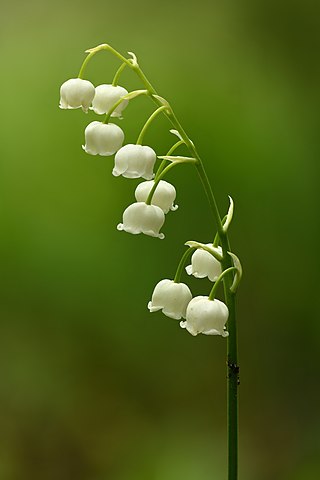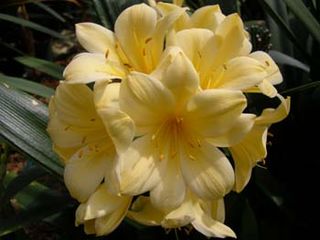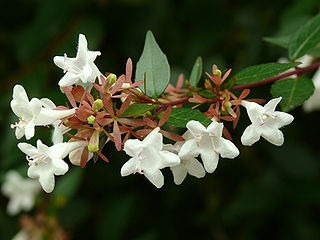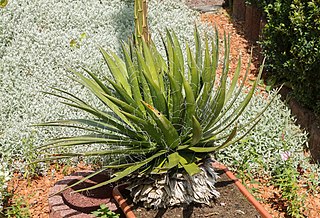
Lily of the valley, sometimes written lily-of-the-valley, is a woodland flowering plant with sweetly scented, pendent, bell-shaped white flowers borne in sprays in spring. It is native throughout the cool temperate Northern Hemisphere in Asia and Europe. Convallaria majalis var. montana, also known as the American lily of the valley, is native to North America.

Pelargonium is a genus of flowering plants that includes about 280 species of perennials, succulents, and shrubs, commonly called geraniums, pelargoniums, or storksbills. Geranium is also the botanical name and common name of a separate genus of related plants, also known as cranesbills. Both genera belong to the family Geraniaceae, and Carl Linnaeus originally included all the species in one genus, Geranium; they were later separated into two genera by Charles Louis L'Héritier de Brutelle in 1789.

Clivia is a genus of monocot flowering plants native to southern Africa. They are from the family Amaryllidaceae, subfamily Amaryllidoideae. Common names are Natal lily or bush lily.

Pieris is a genus of seven species of shrubs in the flowering plant family Ericaceae, native to mountain regions of eastern and southern Asia, eastern North America and Cuba. Known commonly in North America as andromedas or fetterbushes, they are broad-leaved evergreen shrubs growing to 1–6 metres tall and 3–10 ft (0.9–3.0 m) wide. The leaves are spirally arranged, often appearing to be in whorls at the end of each shoot with bare stretches of shoot below; they are lanceolate-ovate, 2–10 cm (0.8–3.9 in) long and 1.0–3.5 cm (0.4–1.4 in) broad, leathery textured, and with an entire or serrated margin. The young leaves in spring are typically brightly coloured. The flowers, which may have a very appealing honey scent, are bell-shaped, 5–15 mm (0.2–0.6 in) long, white or pink, and arranged in racemes 5–12 cm (2.0–4.7 in) long. The fruit is a woody capsule which splits into five sections to release the numerous small seeds.

Trachycarpus fortunei, also known as the Chusan palm, Chinese windmill palm, or simply the Windmill palm, is a species of hardy evergreen palm tree in the family Arecaceae, native to parts of China, Japan, Myanmar, and India.

Abelia × grandiflora is a hybrid species of flowering plant in the honeysuckle family Caprifoliaceae, raised by hybridising A. chinensis with A. uniflora.

Zantedeschia aethiopica, commonly known as calla lily and arum lily, is a species of flowering plant in the family Araceae, native to southern Africa in Lesotho, South Africa, and Eswatini.

Agave victoriae-reginae, the Queen Victoria agave or royal agave, is a small species of succulent flowering perennial plant, noted for its streaks of white on sculptured geometrical leaves, and popular as an ornamental.

Heptapleurum arboricola is a flowering plant in the family Araliaceae, native to Hainan Province, China and Taiwan. Its common name is dwarf umbrella tree, as it resembles a smaller version of the umbrella tree, Heptapleurum actinophyllum.

Aglaonema is a genus of flowering plants in the arum family, Araceae. They are native to tropical and subtropical regions of Asia and New Guinea. They are known commonly as Chinese evergreens.

Acacia retinodes is an evergreen shrub that is native to South Australia, Victoria and Tasmania. Short racemes of yellow flowers are produced periodically throughout the year. Some common names are retinodes water wattle, swamp wattle, wirilda, ever-blooming wattle and silver wattle.

Saxifraga stolonifera is a perennial flowering plant known by several common names, including creeping saxifrage, strawberry saxifrage, creeping rockfoil, Aaron's beard, mother of thousands, roving sailor, and strawberry begonia or strawberry geranium, though it is neither a true begonia nor a geranium; both these latter plants belong to different families.

Pieris japonica, the Japanese andromeda or Japanese pieris, is a species of flowering plant in the heath family Ericaceae. It is native to eastern China, Taiwan, and Japan, where it grows in mountain thickets. This medium-sized evergreen shrub or tree is widely cultivated in gardens.

Acacia pravissima, commonly known as Ovens wattle, Oven wattle, wedge-leaved wattle and Tumut wattle, is a species of flowering plant in the legume family Fabaceae. It is an evergreen shrub native to Victoria, the South West Slopes and Southern Tablelands of New South Wales, Australia.

Sarcococca confusa, the sweet box, is a species of flowering plant in the family Buxaceae, probably native to western China. It is an evergreen shrub growing to 2 m (7 ft) tall by 1 m (3 ft) broad, with glossy green ovate leaves and honey-scented white flowers in winter, followed by glossy black spherical fruits, 5 mm in diameter.

Acer oblongum, common name Himalayan maple, evergreen maple and Kashmir maple, is an evergreen Asian species of maple in the family Sapindaceae.

Agave filifera, the thread agave, is a species of flowering plant in the family Asparagaceae, native to Central Mexico from Querétaro to Mexico State. It is a small or medium-sized succulent plant that forms stemless rosette up to 3 feet (91 cm) across and up to 2 feet (61 cm) tall. The leaves are dark green to a bronzish-green in color and have very ornamental white bud imprints. The flower stalk is up to 11.5 feet (3.5 m) tall and is densely loaded with yellowish-green to dark purple flowers up to 2 inches (5.1 cm) long. Flowers appear in autumn and winter.

Aglaonema simplex, also known as the Malayan sword is a perennial species of flowering plant in the family Araceae. It is native to Southeast Asia.

Aglaonema costatum, called the spotted evergreen, is a species of flowering plant in the genus Aglaonema, native to Bangladesh, Thailand, Peninsular Malaysia, Laos, Cambodia and Vietnam. In these areas, the plant is typically found growing in the understory of tropical rain forests. Its putative form, Aglaonema costatum f. immaculatum, called the unspotted Chinese evergreen, has gained the Royal Horticultural Society's Award of Garden Merit.

Aglaonema commutatum, the poison dart plant, is a species of flowering plant in the Chinese evergreen genus Aglaonema, family Araceae. It is native to the Philippines and northeastern Sulawesi, and has been introduced to other tropical locales, including Cuba, Puerto Rico, Trinidad and Tobago, Comoros, the Chagos Archipelago, India, Bangladesh, and the Cook Islands. Its hybrid cultivar 'Silver Queen' has gained the Royal Horticultural Society's Award of Garden Merit as a houseplant.





















